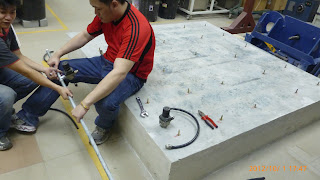A comparison between field dry densities and laboratory proctor compaction test results are shown in the figure. Based on these results, the field dry densities at Site A and Site B can be defined as approximately 1.6 tf/m3 and 1.5 tf/m3 respectively. The rain fall in the previous day of site investigation has made the ground fairy wet, so that the water contents were high at these site, ranging from 18 to 22%. One of field data (first trial test of in-situ density tests) from Site B shows a value above the zero air void curve and therefore this should be disregarded.
FYP students will carry out a series of triaxial test to study the deformation properties of residual soil in small strain range by using both undisturbed and compacted samples. Also shaking table test and hollow cylinder test are planned to study the deformation properties of residual soil in small strain range by using compacted sample.
For further information on FYP studies, please contact us at utar.earthquake@gmail.com.
Comparison of field density test data with laboratory compaction curves















